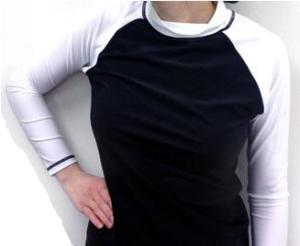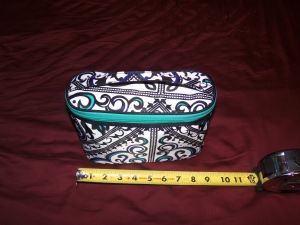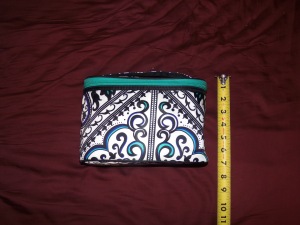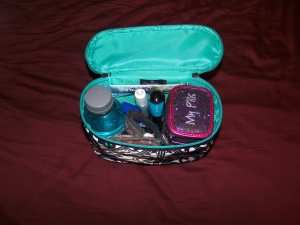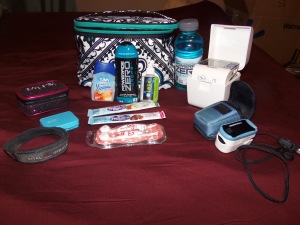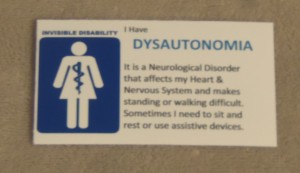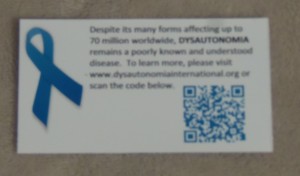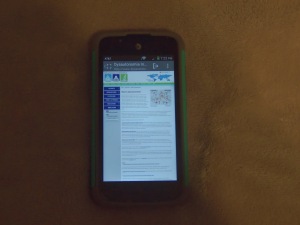When I first set out to find a medical id bracelet, I knew I was going to need a fair bit of space to fit everything I wanted to convey to emergency workers or doctors. I also knew that the information on it was likely to change often, as I felt including my long/weird/rotating list of medications was important. My first stab at a solution for this was the Vital ID medical bracelet. The paper insert allowed me space and flexibility to write (most) everything I wanted, and it stuck out enough that I felt most emergency workers would notice it.

However, I still wanted to be able to convey more. I began looking for more “techie” solutions to the problem. I had seen the USB based medical jewelry, but had been warned EMTs would not be able to access it and Hospitals were too cautious to put foreign USBs in to their computers anymore thanks to the increasing problems with hacking/malware/identity theft breeches (big HIPPA fines). So that was out. Then I stumbles across QR code based medical jewelry.

A QR code, for those unaware, is kind of like a barcode on steroids. In many cases, it allows you to link directly to a specific, online website. Once pretty obscure, they continue to grow in popularity, and not just for medical ids. Checked out you McDonald’s cup recently? You will probably find a QR code linking you directly to the nutrition information. Need video instruction on how to put together your kids new toy? Scan the QR code to be taken to step by step YouTube instructions. Once you start looking for them, you will start spotting them everywhere.

Their popularity is increasing, partly due to the fact they are pretty much universal (no matter which QR code app you use, they all go to the same place) and partly because everyone plus their dog has a smart phone. No longer do I have to go home and hop on the laptop to know the fat content of my Big Mac, just scan the QR code with my phone and I have instant access. As Dean Pelton would say, easy peasy lemon squeezy.

Thus, the point of a QR code based medical id is to link to an online website that has your medical info.
After researching different companies that offered QR code medical jewelry, I decided on My ID Square. One of the most important factors for me was the lack of a yearly fee–my “Squid” purchase came with a lifetime subscription to the website. I had also read reviews that said My ID, another prominent QR code medical jewelry company, had problems with their QR codes wearing off and becoming unusable. The Squid can be accessed both via a smartphone with any QR code reader (many to choose from, most are free) or online via a website and pin code.

The variety of accessories that was available on the My ID Square site was a definite plus, though it is easy to see that bracelets/necklaces not from them would work just as well when paired with the Squid. Taking advice from EMT’s I had spoken with, however, I did not want to make my bracelet too “jewelry like” and thus went with a plain silicone band.
I also liked the clip-on charms they recommend, a way to get across quickly your medical condition before scanning the squid and help draw attention to the bracelet. The ‘multiple medications’ one certainly fit, but otherwise the closest thing to what I have was the generic ‘heart condition’. However, then something really cool happened. After several requests, they company offered a pre-order for a POTS charm. If they got 12 orders, they would go ahead and make the charm! Not long after, request and pre-orders for Dysautonomia, EDS, and Gastroparesis were made. But they had me at POTS, I had to have one.

I waited anxiously for my new squid, charms, and bracelet to arrive. Seemed like forever, but it was only like 2 weeks. Since then, I have been very pleasantly surprised how much I like it. I was somewhat dubious about the silicone bracelet; I was worried it would look silly/tacky for someone my age to be wearing a silicone bracelet. But I actually really like it. I, of course, got it in Aqua for Dysautonomia, and was happy how similar to turquoise it is. And, not surprisingly, it is pretty comfortable. The actual color of the Squid I wanted was out of stock, but it retrospect I think my second choice color actually works better.

The web profile was easy to activate and simple to input the information. It offered options for
- Name, age, photo, languages spoken
- Primary doctor and contact info
- All other doctor’s contact info
- Emergency contacts phone, text and email
- Medication, food and other allergies
- Surgeries
- Medical Problems
- Medical Devices
- Medications
- Pharmacy
- Advanced Directive information
- Date of last tetanus shot
- Where your electronic health records are stored
- Preferred Care Center
It also has a spot where you can put general information that might be pertinent in an emergency, such as where a epi pen can be found, or in my case, to give fluids. It also gives the option to download or email the information if wanted. It cannot, however, link to a full EMR record, at least not currently.
As a final neat trick, anyone who scans your squid can press a button to alert your emergency contacts that your Squid has been accessed. You can set it up so they receive a text, email, or both.

I do wish it had a little more room and/or areas where I could give instructions. The lovely thing about having a condition nobody has ever heard of is you spend A LOT of time explaining to doctors how to treat you. I carry summary medical journal articles of my conditions in my purse, you know, just in case google happens go down or something. I would love a bit more space to include “more information” links about my conditions or detailed instructions from my specialists.
Thankfully, I have not had my Squid scanned yet (by medical professionals, anyway). I asked a couple of local first responders if they would know what to do if they saw one, and that has been a bit of a mixed bag. However, they all thought it was really cool after learning about it. Hopefully as the word about this kind of technology gets out, awareness of how to use it will improve as well.
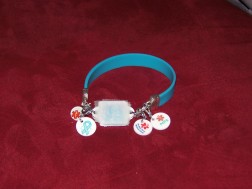
For me, one of the most comforting facts about having the Squid is that both my husband and myself are able to scan it. The majority of the times I have ended up in the ER, it is because my husband is taking me in to get fluids after an episode. I don’t need an ambulance, but I do need a liter or two of fluids. And if it is to the point I am needing to go in for fluids, I am usually not at the top of my game. I am often out of breath, brain foggy as all get out, and filling out forms while describing my multiple conditions is not exactly easy. Now, either of us can just scan the Squid and hand it over. Could I do the same things with a piece of paper in the purse or wallet . . . probably. But this is much easier to update (vs. editing and reprinting or someone trying to read my chicken scratch) and my phone is always on me–not always so with my purse. It did, however, prompt me to finally upgrade to a knock-off brand smartphone. So I guess I can also thank it for also nudging me into the 21st century.

(My previous phone–most of you probably don’t even know what this is)
In terms of security, someone must scan the QR code or visit the website with your personal pin code (on the back of the squid). As you can see, I covered my squid with tape before taking a picture as you can access the online profile even by scanning a clear enough picture. For this reason, I also tend to wear it on the inside of wrist, though I doubt someone could get close enough to scan it without me noticing. Plus, I figure if I end up on the floor, I will probably be palms up anyway.

According to the company, the info is protected behind a “firewall protected secure database. Customer information is never shared, sold, or otherwise provided to third parties.” Obviously, if it is on the internet, it runs the risk of being hacked. But with the mandate for medical records to go electronic as well as several high-profile hacks of big healthcare companies (one of which I know my data was included in), I figure my medical info is probably going to get out eventually anyway. Heck, the NSA probably knew what I had before the Doctors did. Even so, I only put information on my profile that I feel pretty comfortable about if it somehow did get out. For instance, I do not put my address, my insurance information, and for the love of all that is holy, DO NOT put you Social Security number on there. In my mind, the risk of it getting hacked is pretty minimal, especially since my Squid profile contains at lot less info than some of my other electronic medical records.

The one problem that I had with my Squid medical id was actually a problem with the POTS charm I was so excited about. Unfortunately, after a few months, the ‘POTS’ started to rub off of the charm. I contacted the company to let them know about it, and they reported that there appeared to be a defect in the manufacturing process, and that others had reported similar problems with their POTS charms. The offered to replace the charm with a new one after they finished switching charm manufacturers in a few weeks.
I am happy to report that they did replace the charm, and it now seems to have some sort of protective coating to prevent it from happening again. They replaced and mailed it free of charge, and even emailed afterward to make sure I was happy with it. So A+ for customer service!
Overall, I am pretty pleased with my Squid medical id. However, I will add that I do not exclusively wear my Squid. I also continue to wear my Vital Id bracelet as well. I figure by wearing both, I have all my bases covered. I realize not everyone knows what a QR code is, and rural emergency responders are not always issued smartphones as part of their job. Indeed, in my mind, I keep my traditional medical id around more for the EMTs/field responders, the Squid for the emergency room/hospital. However, I figure if we are talking about emergencies, the more options covered, the better.
Squid medical id’s by My ID Square, available in both a charm and as a dog tag. $58 at http://www.myidsquare.com/pages/squids-square-ids-that-connect-to-medical-profile
Bonus: Sales of the Dysautonomia charm benefit Dysautonomia International













